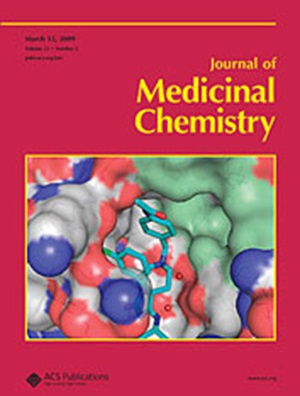Design and Development of a Novel BET Protein-Targeted PET Imaging Probe for In Vivo Characterization of Alzheimer’s Disease Pathophysiology
IF 6.8
1区 医学
Q1 CHEMISTRY, MEDICINAL
引用次数: 0
Abstract
BET proteins are essential epigenetic regulators involved in gene transcription and have been linked to neurodegenerative disorders, such as Alzheimer’s disease (AD). In vivo imaging of BET proteins may provide insights into disease pathophysiology and help identify potential therapeutic targets. We developed a carbon-11-labeled radiotracer, [11C]YL9, which exhibits high binding affinity for BET proteins. It was synthesized via standard methylation and evaluated for brain uptake, binding specificity, and pharmacokinetics in wild-type and AD mouse models using PET imaging and autoradiography. [11C]YL9 demonstrated excellent blood-brain barrier penetration, prolonged retention, and strong BET protein binding. In AD mice, [11C]YL9 uptake was significantly higher than in wild-type mice, suggesting increased BET protein availability. These findings suggest that [11C]YL9 is a promising PET radioligand for noninvasive BET protein imaging. Its high specificity and favorable pharmacokinetics make it a valuable tool for studying BET protein involvement in neurodegeneration.

一种新型BET蛋白靶向PET成像探针的设计与开发,用于阿尔茨海默病病理生理的体内表征
BET 蛋白是参与基因转录的重要表观遗传调节因子,与阿尔茨海默病(AD)等神经退行性疾病有关。对 BET 蛋白进行体内成像可深入了解疾病的病理生理学,并有助于确定潜在的治疗靶点。我们开发了一种碳-11 标记的放射性示踪剂 [11C]YL9,它与 BET 蛋白具有很高的结合亲和力。我们通过标准甲基化合成了这种放射性示踪剂,并使用 PET 成像和自显影技术评估了野生型和 AD 小鼠模型的脑摄取、结合特异性和药代动力学。[11C]YL9表现出极好的血脑屏障穿透性、长时间的保留性和很强的BET蛋白结合性。在AD小鼠中,[11C]YL9的摄取量明显高于野生型小鼠,这表明BET蛋白的可用性增加了。这些研究结果表明,[11C]YL9 是一种用于无创 BET 蛋白成像的 PET 放射配体。它的高特异性和良好的药代动力学使其成为研究 BET 蛋白参与神经变性的重要工具。
本文章由计算机程序翻译,如有差异,请以英文原文为准。
求助全文
约1分钟内获得全文
求助全文
来源期刊

Journal of Medicinal Chemistry
医学-医药化学
CiteScore
4.00
自引率
11.00%
发文量
804
审稿时长
1.9 months
期刊介绍:
The Journal of Medicinal Chemistry is a prestigious biweekly peer-reviewed publication that focuses on the multifaceted field of medicinal chemistry. Since its inception in 1959 as the Journal of Medicinal and Pharmaceutical Chemistry, it has evolved to become a cornerstone in the dissemination of research findings related to the design, synthesis, and development of therapeutic agents.
The Journal of Medicinal Chemistry is recognized for its significant impact in the scientific community, as evidenced by its 2022 impact factor of 7.3. This metric reflects the journal's influence and the importance of its content in shaping the future of drug discovery and development. The journal serves as a vital resource for chemists, pharmacologists, and other researchers interested in the molecular mechanisms of drug action and the optimization of therapeutic compounds.
 求助内容:
求助内容: 应助结果提醒方式:
应助结果提醒方式:


